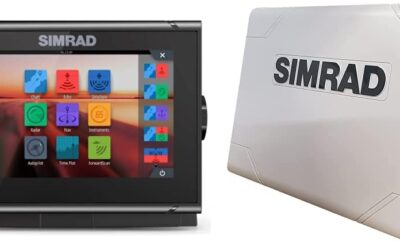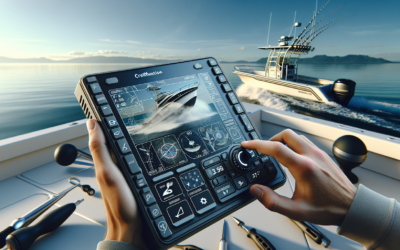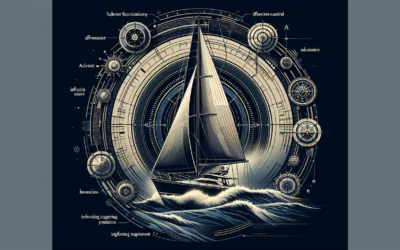Imagine never having to worry about buying a new fish finder again as your fishing needs evolve and change. With “The Future-Proof Fish Finder: Options That Grow With Your Expanding Needs,” you have a solution that adapts to your fishing style and equipment preferences over time. This innovative product eliminates the need to constantly upgrade your fish finder, ensuring that you always have the latest features and technology at your fingertips. Whether you’re a seasoned angler or just starting out, this fish finder has the flexibility to meet your current and future fishing needs, making it the perfect companion for any fishing adventure.
Fish Finder Basics
Understanding Fish Finders
Fish finders are valuable tools for any angler. They use sonar technology to locate fish and display their positions on a screen. This allows you to identify fish hotspots, determine water depth, and even locate underwater structures. Understanding how fish finders work is essential to getting the most out of this technology.
How Fish Finders Work
Fish finders work by emitting sound waves, which travel through the water and bounce off objects such as fish and underwater structures. The time it takes for the sound waves to return is measured, and this data is used to create detailed images of what lies beneath the surface. These images are then displayed on the fish finder’s screen, allowing you to see where the fish are in relation to your boat.
Types of Fish Finders
There are various types of fish finders available, each with its own features and capabilities. The two main types are standalone fish finders and integrated fish finder systems. Standalone fish finders are portable devices that are often mounted on a boat or kayak. Integrated fish finder systems, on the other hand, are built-in units that combine fish finding capabilities with other marine electronics, such as GPS and chartplotters.
Considerations when Choosing a Fish Finder
Water Type and Depth
Before purchasing a fish finder, it’s important to consider the type of water you’ll be fishing in and the depth at which you’ll typically be fishing. Different fish finders are designed to perform optimally in specific water conditions. For example, some fish finders are better suited for freshwater fishing, while others are specifically designed for saltwater environments.
Screen Size and Resolution
The screen size and resolution of a fish finder are important factors to consider. A larger screen allows for easier viewing and interpretation of the fish finder’s images. Additionally, a higher resolution screen will display more detailed images, enhancing your ability to identify fish and underwater structures.
Frequency and Power
The frequency and power of a fish finder’s sonar system will impact its performance. Higher frequencies are ideal for shallow water fishing, as they provide more detailed images. Lower frequencies, on the other hand, are better suited for deep water fishing, as they can penetrate deeper.
Transducer Type
The transducer is a crucial component of a fish finder, as it sends and receives the sonar signals. There are various types of transducers available, each with its own characteristics. For example, some transducers are designed for mounting on the hull of a boat, while others are designed for side imaging or down imaging.
GPS and Mapping Capability
Some fish finders come equipped with GPS and mapping capabilities, allowing you to not only locate fish but also navigate and map your fishing spots. This can be particularly useful when fishing in unfamiliar areas or when trying to mark specific underwater structures for future reference.
Expandable Fish Finder Options
Modular Fish Finders
Modular fish finders are a great option for those who want to customize their fish finder setup. These systems consist of separate modules that can be easily connected and disconnected, allowing you to add or remove features as needed. For example, you could start with a basic fish finder module and then add on additional modules, such as a GPS module or a side imaging module, as your needs evolve.
Upgradable Software
Some fish finders offer upgradable software, which allows you to download new features and functionalities as they become available. This ensures that your fish finder stays up to date with the latest advancements in technology, even after you’ve made your initial purchase. Upgradable software is a great option for those who want to future-proof their fish finder and avoid the need for frequent equipment upgrades.
Transducer Compatibility
When choosing a fish finder, it’s important to consider the compatibility of the transducer with your existing equipment. Some fish finders are compatible with a wide range of transducers, while others have specific requirements. Ensuring that your fish finder and transducer are compatible will save you time and money in the long run.
Wireless Fish Finders
Bluetooth Connectivity
Bluetooth connectivity allows you to wirelessly connect your fish finder to other devices, such as your smartphone or tablet. This opens up a world of possibilities, such as using your mobile device as a secondary screen or controlling your fish finder remotely. Additionally, some fish finders with Bluetooth connectivity can even sync with compatible fishing apps, providing you with access to additional features and data.
Wi-Fi Connectivity
Wi-Fi connectivity is another wireless option offered by some fish finders. With Wi-Fi connectivity, you can connect your fish finder to the internet, allowing you to access real-time weather updates, stream maps and charts, and even share your fishing experiences on social media. Wi-Fi connectivity is especially useful for anglers who enjoy fishing in unfamiliar areas or who want to stay connected while out on the water.
Wireless Sonar Technology
Wireless sonar technology takes wireless fish finders to a whole new level. Instead of relying on cables and wires to transmit sonar signals, wireless sonar technology uses wireless transmitters and receivers to send and receive data. This eliminates the need for messy cables and allows for greater freedom and flexibility in mounting and using your fish finder.
Fish Finder Apps
Mobile Fish Finder Apps
Mobile fish finder apps are a convenient way to access fish finding capabilities on your smartphone or tablet. These apps leverage your device’s built-in GPS and sonar capabilities, allowing you to turn your phone or tablet into a fish finder. Mobile fish finder apps typically offer features such as depth charts, fish location maps, and real-time sonar imaging.
Compatibility with Different Devices
When choosing a fish finder app, it’s important to ensure that it is compatible with your specific device. Some apps are only available for iOS devices, while others are only compatible with Android devices. Additionally, you’ll want to consider the app’s compatibility with different screen sizes and resolutions, as this can impact the app’s usability and functionality.
Advanced Features of Fish Finder Apps
Fish finder apps often come with a range of advanced features that can enhance your fishing experience. These features can include things like the ability to mark and save fishing spots, customize maps, and share fishing data with other anglers. Some apps even offer augmented reality features, allowing you to overlay fish and underwater structures onto the camera feed of your device.
Integrated Fish Finder Systems
Combining Fish Finder with GPS
Integrated fish finder systems combine fish finding capabilities with GPS functionality. This allows you to not only locate fish but also navigate to specific fishing spots with ease. Integrated systems often come with preloaded maps and charts, making it easy to find and mark underwater structures. Additionally, some integrated systems offer features such as autopilot, route planning, and even weather updates.
Multi-Touch Interface
Many integrated fish finder systems feature a multi-touch interface, similar to what you would find on a smartphone or tablet. This intuitive interface makes it easy to navigate through menus, zoom in and out of maps, and customize settings. A multi-touch interface can greatly enhance your user experience and make using your fish finder a breeze.
Network Connectivity
Integrated fish finder systems often come equipped with network connectivity options, allowing you to connect multiple devices and share data. For example, you could connect your fish finder to other devices on your boat, such as a chartplotter or a radar, creating a seamless and integrated marine electronics system. Network connectivity can greatly enhance your fishing experience by providing you with access to a wealth of data and functionality.
Other Integrated Features
In addition to fish finding and GPS capabilities, integrated fish finder systems offer a range of other integrated features. These can include things like radar, AIS (Automatic Identification System), and even entertainment options such as music and video streaming. Integrated systems provide a comprehensive solution for anglers who want all their marine electronics in one convenient package.
Portable Fish Finders
Benefits of Portable Fish Finders
Portable fish finders offer a range of benefits for anglers who are constantly on the go. These devices are lightweight and compact, making them easy to transport and store. They can be quickly and easily mounted on different boats or even used from the shore. Portable fish finders are also a great option for anglers who rent boats or don’t want to permanently install a fish finder on their vessel.
Portable Fish Finder Options
There are several options available when it comes to portable fish finders. One option is a handheld fish finder, which is a self-contained unit with a built-in transducer and screen. Another option is a castable fish finder, which can be attached to your fishing line and cast into the water. Both options offer portability and convenience, allowing you to take your fish finder wherever your fishing adventures may lead.
Ease of Use and Installation
Portable fish finders are designed to be user-friendly and easy to install. They typically come with intuitive menus and settings, making it easy for anyone to use, regardless of their level of fishing experience. Installation is usually as simple as mounting the transducer or casting the device into the water. Portable fish finders are a great option for anglers who want a hassle-free fish finding experience.
Future Innovations in Fish Finders
Artificial Intelligence in Fish Finders
The future of fish finders is set to be even more advanced with the integration of artificial intelligence (AI). AI technology has the potential to revolutionize fishing by allowing fish finders to analyze sonar data in real-time and provide intelligent insights and predictions. For example, AI-powered fish finders could analyze fish behavior patterns and make recommendations on the best fishing techniques to use based on current conditions.
Virtual Reality Integration
Virtual reality (VR) integration is another exciting future innovation in fish finders. This technology would allow anglers to immerse themselves in a virtual underwater world, providing a realistic and interactive fishing experience. With VR integration, you could explore underwater environments, interact with virtual fish, and even practice your fishing techniques in a virtual setting.
Autonomous Fish Finding Technology
Autonomous fish finding technology is a concept that is currently being explored by researchers and innovators. The idea is to develop fish finders that are capable of operating autonomously, without the need for human intervention. These autonomous fish finders would use advanced sensors and algorithms to detect, track, and locate fish, making fishing more efficient and reducing the need for manual fish finding.
Choosing the Right Fish Finder for Your Needs
Assessing Your Fishing Requirements
When choosing a fish finder, it’s important to assess your specific fishing requirements. Consider the types of fish you typically target, the water conditions you fish in, and the depth at which you fish. Think about the features and functionalities that are most important to you and ensure that the fish finder you choose meets those needs.
Budget Considerations
Fish finders come in a wide range of prices, so it’s important to set a budget before making a decision. Determine how much you are willing to spend and look for fish finders that fall within that price range. While it can be tempting to go for the most advanced and feature-packed option, it’s important to weigh the cost against the value you will derive from those additional features.
Reading User Reviews
Reading user reviews is a great way to get a sense of the performance and reliability of a fish finder. Look for reviews from anglers who fish in similar conditions and target similar fish as you do. Pay attention to the pros and cons mentioned in the reviews and use this information to make an informed decision.
Getting Expert Advice
If you’re still unsure about which fish finder to choose, consider seeking expert advice. Visit local fishing stores and talk to the staff, who are often experienced anglers themselves. They can provide valuable insights and recommendations based on their expertise and knowledge of the local fishing conditions.
Conclusion
Making an informed decision when choosing a fish finder is essential. By understanding the basics of fish finders, considering your specific fishing requirements, and exploring the various options available, you can select a fish finder that meets your needs and grows with you as your fishing skills and ambitions expand. Whether you opt for a portable fish finder, a wireless option, an integrated system, or even an advanced future-proof model, investing in the right fish finder will enhance your fishing experience and increase your chances of success on the water.









